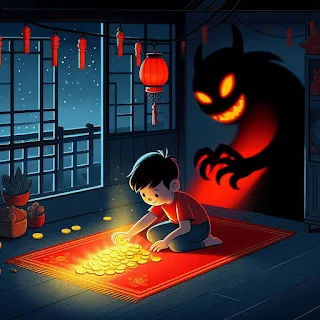The Origin of Red Envelopes: A Lunar New Year Tradition
Long ago, in a small Chinese village, there lived a kind and hardworking young boy named Wei. Wei was known for his generosity and his love for helping others, especially the elders in his village. During the New Year season, when the villagers celebrated the arrival of spring, they would gather to share food, laughter, and blessings for the year ahead.
One year, a terrible rumor spread that a mischievous demon called Sui would appear on New Year’s Eve to harm children. The villagers were terrified, for Sui was known to visit children at night, causing them to fall ill with a strange sickness.
Wei’s family, like all others in the village, worried for their children’s safety. To protect them, parents tried everything—hanging talismans, lighting lanterns, and staying awake through the night. Despite these efforts, Sui continued to wreak havoc.
One evening, as Wei sat by the fire with his parents, a knock echoed on their door. An old sage, carrying a bag and a walking stick, stood outside.
“Who are you?” Wei’s father asked cautiously.“I am a traveler who has heard of your troubles,” the sage replied, his voice calm but firm. “I know how to protect your children from Sui.”
Wei’s mother stepped forward, her voice trembling with hope. “Please, wise one, tell us how we can keep our children safe!”
The sage nodded and opened his bag, revealing a handful of gold coins and bright red paper. “This demon fears two things: the glint of gold and the color red. Wrap a coin in this paper and place it under your child’s pillow. When Sui comes, it will be driven away by the light.”
Wei’s father furrowed his brow. “Are you certain this will work?”
The sage smiled knowingly. “Trust me, it will.”
That night, Wei’s parents followed the sage’s advice. As Wei climbed into bed, he held the small red-wrapped coin in his hands, curious about its power.
“Will this really keep Sui away?” Wei asked, looking up at his mother.
His mother knelt beside him, tucking him in. “Yes, my dear. The wise man said it will protect you. Sleep peacefully.”
As midnight approached, the house grew silent, but the air felt heavy. Suddenly, a faint growl echoed outside. Sui had arrived. The demon crept into Wei’s room, its clawed hands reaching toward the boy. But as soon as it touched the pillow, the red paper began to glow, and the gold coin emitted a brilliant light.
Sui let out a shriek. “What is this magic?!” it roared, retreating in fear. The demon fled into the night, never to return.The next morning, Wei ran out of his room, holding the red-wrapped coin. “It worked! The demon didn’t hurt me!”
The villagers gathered to hear Wei’s story. His father spoke with gratitude, “The sage’s wisdom has saved us all. We must share this knowledge with everyone.”
The following year, on New Year’s Eve, every family in the village wrapped coins in red paper and placed them under their children’s pillows. Sui never returned, and the village was safe.
Over time, the practice became a cherished tradition. Instead of hiding the red-wrapped coins, people began handing them directly to children as blessings. The red envelopes, known as angpau, symbolized protection, good luck, and prosperity.
Today, red envelopes are an essential part of the Lunar New Year celebration. Elders and married couples give angpau to children and younger relatives, wishing them happiness and success in the coming year. The envelopes, now often decorated with gold symbols or characters, are filled with money as a gesture of goodwill and blessings.
Though the tradition has modernized, the spirit of giving and protection remains rooted in the story of Sui. The red envelope is more than just a container for money—it is a symbol of love, care, and the hope for a bright future.



.jpg)
%20Saving%20the%20Cow%20from%20the%20Crocodile.webp)







No comments:
Post a Comment
Share your opinion about this story . . .